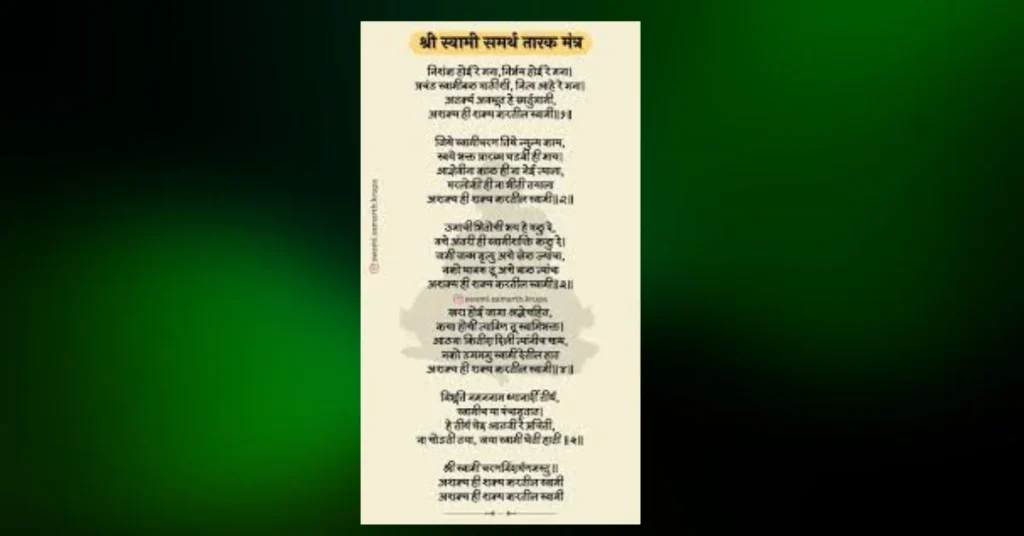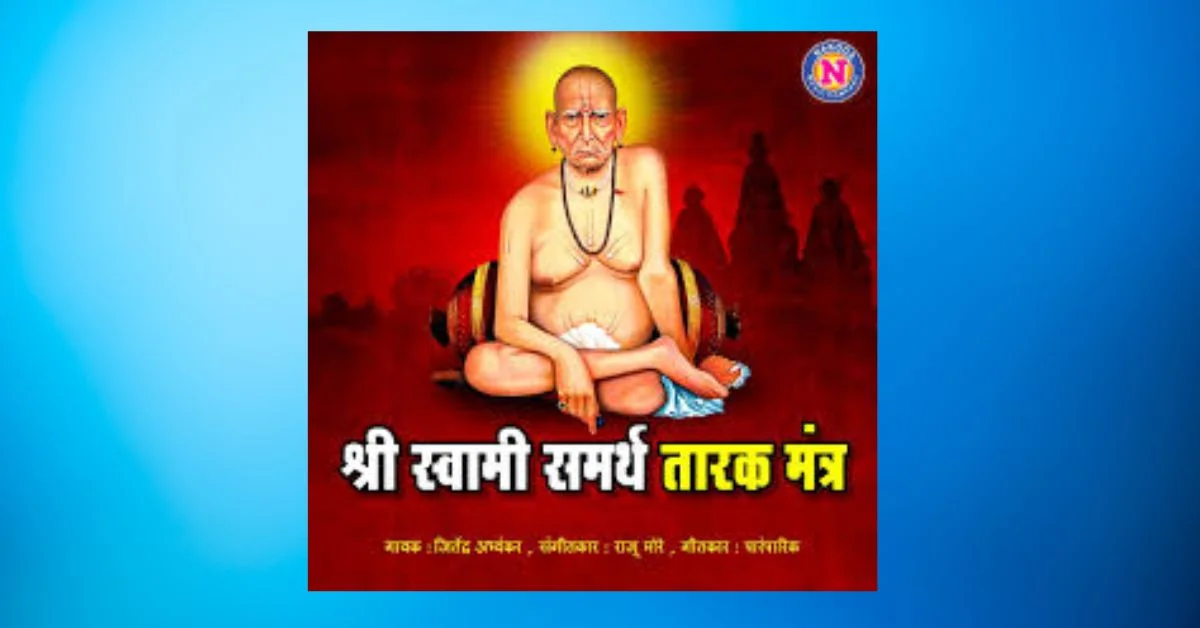If you’ve come looking for the Swami Samarth Tarak Mantra lyrics, you’re not just searching for words — you’re reaching toward a deeper spiritual path that countless devotees have walked for centuries. This article offers more than a simple lyric sheet. It gives you the complete mantra, its exact meaning, spiritual implications, ritualistic use, and how the mantra continues to evolve in modern spiritual practice.
The Swami Samarth Tarak Mantra isn’t just a chant — it’s a gateway to inner peace, mental clarity, and divine connection. This guide will help you understand why, how, and when to chant this powerful mantra and integrate it into your personal practice.
Who Is Swami Samarth?
To understand the Tarak Mantra, we must begin with Swami Samarth of Akkalkot, a 19th-century saint believed to be an incarnation of Lord Dattatreya. Born in Maharashtra and revered across India, Swami Samarth is known for his miraculous powers, healing energy, and teachings centered around faith, surrender, and inner discipline.
Thousands of devotees turn to him in times of mental unrest, physical suffering, or life uncertainty. He is called “Tarak” — the one who liberates. And it is this liberating power that forms the basis of his Tarak Mantra.
What Is the Swami Samarth Tarak Mantra?
The Swami Samarth Tarak Mantra is a short but potent Sanskrit invocation recited by devotees for spiritual protection, peace of mind, and removal of obstacles. The mantra is rooted in Bhakti (devotion) and holds a tremendous vibrational impact when chanted sincerely and regularly.
The Full Tarak Mantra:
“Om Abhayadata Shree Swami Samarthaya Namah”
(In Marathi Script: ॐ अभयदाता श्री स्वामी समर्थाय नमः)
This is the most widely accepted and powerful form of the Tarak Mantra, though regional variations and longer versions may exist in different traditions or temples.
Meaning of Each Word in the Mantra
Breaking down the mantra helps to understand the spiritual message it carries:
- Om: The primordial vibration — the sound of the universe and a call to spiritual awareness.
- Abhayadata: The one who gives fearlessness; protector from sorrow, pain, and spiritual ignorance.
- Shree: A respectful prefix denoting reverence and divine presence.
- Swami Samarthaya: Refers to Swami Samarth, the spiritual master and liberator.
- Namah: I bow down; an expression of surrender and gratitude.
Together, the mantra translates to:
“I bow to Swami Samarth, the divine giver of fearlessness.”
This is not just a prayer — it is a declaration of surrender, a plea for guidance, and an invitation to grace.

When and How to Chant the Swami Samarth Tarak Mantra
Ideal Times:
- Early morning (Brahma Muhurta) between 4 AM – 6 AM
- Sunset hours, during evening prayers
- Before embarking on a challenging task
- During periods of stress or anxiety
- As part of daily meditation or japa
Recommended Practices:
- Chant the mantra 108 times using a rudraksha mala or tulsi beads
- Light a diya (lamp) before a picture or idol of Swami Samarth
- Maintain focus on the breath while chanting
- If possible, sit facing east during morning chants and west in the evening
Psychological and Spiritual Benefits of the Tarak Mantra
The mantra is known to have powerful psychological, emotional, and energetic benefits when practiced consistently:
1. Mental Peace and Clarity
The vibrational frequency of this mantra calms the nervous system. The name “Abhayadata” has a psychological effect—it programs the subconscious to believe in protection and safety.
2. Courage During Difficult Times
People struggling with fear, uncertainty, or grief report a sense of courage and groundedness after regular recitation.
3. Protection from Negative Energies
Devotees believe the mantra creates a spiritual shield against unseen forces and negative thoughts.
4. Awakening Inner Strength
By surrendering to Swami Samarth, the practitioner aligns with a force greater than ego, which helps dissolve helplessness and re-awaken spiritual purpose.
How the Mantra Fits Into Daily Devotion
The mantra can be a standalone spiritual practice or integrated into your existing sadhana:
- Start your day with 11 repetitions of the mantra
- Chant it before exams, interviews, or travel
- Use it as a soothing bedtime chant for children or elders
- Include it during aartis and bhajans in temples or homes
If you’re someone new to mantra chanting, even a few sincere repetitions can start to bring a change in your energetic field. Swami Samarth is known to respond to faith, not formality.
The Role of the Mantra in Swami Samarth Temples
In temples dedicated to Swami Samarth—especially in Akkalkot, Pune, Solapur, and Mumbai—the mantra is chanted daily by priests and devotees alike. It is also:
- Carved into temple walls
- Printed on temple donation receipts
- Played over loudspeakers during morning and evening rituals
Many temples observe Swami Samarth Jayanti with 108 or 1008 repetitions of the Tarak Mantra, often organized as community chants or spiritual gatherings.
Personal Stories and Devotee Experiences
Numerous devotees from across India share transformative stories linked to the Tarak Mantra:
- A mother who chanted the mantra during her child’s illness reported unexpected recovery.
- A student used it as a mental anchor during exam stress.
- An elderly woman battling loneliness found companionship and courage through daily chanting.
While individual experiences may differ, the common thread remains—faith meets response.
The Swami Samarth Movement in 2025: Digital Devotion
As spirituality goes digital, the Swami Samarth Tarak Mantra is now being accessed and recited through:
- Mantra apps with counters and timers
- YouTube bhajans offering 1-hour looped chants
- Spotify playlists that integrate the mantra with ambient music
- Instagram Reels where youth share chanting moments and Swami’s images
Even in this new, connected world, the core emotion of surrender and devotion remains unchanged.
Understanding Swami Samarth’s Tarak Nature
Swami Samarth is known not just as a guru, but a Tarak, meaning the liberator of souls. His mantra functions not only in the material realm but also in the subtle planes of karma, thoughts, and samskaras (past impressions).
Chanting his name is believed to:
- Burn past negative karma
- Neutralize harmful planetary effects
- Draw guidance from the guru’s consciousness
- Assist in soul transition during death (in the case of terminally ill devotees)
Thus, the mantra has both worldly and otherworldly dimensions—a rare balance in modern spiritual literature.
Why This Mantra Still Resonates Today
In a fast-paced world of fleeting attention and constant crisis, the Swami Samarth Tarak Mantra offers stillness, strength, and sanctuary. It’s short enough for daily use, yet profound enough to anchor a lifetime of devotion.
Unlike complex rituals or philosophical texts, this mantra asks only two things: faith and repetition. And in return, it promises peace, protection, and presence—the kind that only comes from connection with a timeless spiritual force.
Conclusion
The Swami Samarth Tarak Mantra is not just a chant—it’s a lifeline for millions who seek inner peace, courage, and connection to a divine force. In 2025, as we live in an increasingly digital and distracted world, this mantra is a gentle but powerful reminder that we are not alone.
Swami Samarth, the giver of fearlessness, still watches over his devotees. And every time his name is chanted with sincerity, that protection deepens. Make the mantra a part of your daily rhythm—not as an obligation, but as a conversation with the divine.
FAQs
1. What is the exact Swami Samarth Tarak Mantra?
The most widely accepted version is:
“Om Abhayadata Shree Swami Samarthaya Namah”
It means “I bow to Swami Samarth, the giver of fearlessness.”
2. How many times should I chant the mantra daily?
Traditionally, it is chanted 108 times using a mala. Beginners can start with 11 or 21 repetitions, building up gradually.
3. Can non-Maharashtrians or non-Hindus chant this mantra?
Yes. Swami Samarth’s teachings are universal and non-sectarian. Anyone with sincere intent can chant the mantra.
4. Is there a specific day to start chanting the Tarak Mantra?
While you can start any day, Thursdays and Purnima (full moon) days are considered especially auspicious.
5. Are there any side effects or precautions?
There are no side effects. However, approach the mantra with respect, mental focus, and consistency for best results.
For more information, click here.









